Digital Poster
Advances in Psychoradiology
ISMRM & ISMRT Annual Meeting & Exhibition • 03-08 June 2023 • Toronto, ON, Canada

| Computer # | |||
|---|---|---|---|
4751.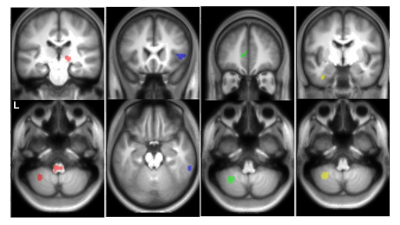 |
161 |
Microstructural Alterations in Schizophrenia evaluated by
Multidimensional Diffusion MRI and Inhomogeneous Magnetization
Transfer Imaging
Khin Khin Tha1,
Maho Kitagawa2,
Samo Lasic3,
Karin Bryskhe3,
Jihun Kwon4,
Marteen Versluis5,
and Naoki Hashimoto6
1Global Center for Biomedical Science and Engineering, Hokkaido University Faculty of Medicine, Sapporo, Japan, 2Laboratory for Biomarker Imaging Science, Hokkaido University Graduate School for Biomedical Science and Engineering, Sapporo, Japan, 3Random Walk Imaging, Lund, Sweden, 4Philips Japan, Tokyo, Japan, 5Philips Healthcare, Best, Netherlands, 6Department of Psychiatry, Hokkaido University Faculty of Medicine, Sapporo, Japan Keywords: Psychiatric Disorders, Diffusion/other diffusion imaging techniques, schizophrenia, multidimensional diffusion This prospective study aimed to identify the role of multidimensional diffusion (MDD) MRI and inhomogeneous magnetization transfer (ihMT) imaging, the former reported as capable of quantifying various microstructural diffusion properties and differentiating tissue-specific subparts and the latter as selective to changes in myelin, in underpinning the microstructural brain changes in schizophrenia. Alterations in MDD MRI indices were observed, associated with negative symptoms of schizophrenia. Altered size and shape of cells other than myelin (probably glia or neurons) are thought as coined in the pathophysiological mechanisms. |
|
4752.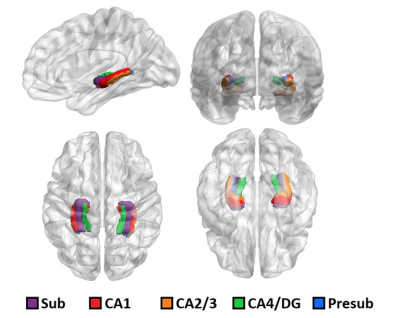 |
162 |
Reduction of Hippocampal Subfield Volumes in Treatment-Resistant
Depression using ASHS: A 7-Tesla Study
Judy Alper1,
Gaurav Verma1,
Shams Rashid1,
and Priti Balchandani1
1Icahn School of Medicine at Mount Sinai, New York, NY, United States Keywords: Psychiatric Disorders, High-Field MRI Major depressive disorder has complex pathophysiology. It is critical to understand treatment-resistant depression (TRD) specifically, as there are many patients for whom no sufficient treatment exists. In this study we assess volumetric differences in hippocampal subfields between TRD patients and healthy controls (HC) using automatic segmentation of hippocampal subfields and ultra-high field MRI. 13 TRD patients and 13 HC underwent imaging using 7-Tesla MRI. ASHS software produced automated hippocampal segmentation for volumetric analysis. Compared to HC, TRD patients showed reduced right-hemisphere CA2/3 subfield volume. Determining biomarkers for TRD pathophysiology may elucidate the underlying mechanisms of treatment-resistant depression. |
|
4753.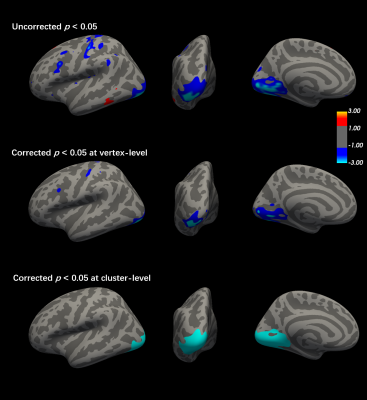 |
163 |
Surface-based morphometric abnormalities in patients with early
psychosis: an MP2RAGE-based study at 7T
Zirun Wang1,
Yasser Alemán Gómez2,
Martine Cleusix2,
Raoul Jenni2,
Luis Alameda2,
Philippe Conus3,
Merixell Bach Cuadra4,5,
Patric Hagmann6,
Kim Q. Do2,
and Lijing Xin1
1Animal imaging and technology core (AIT), Center for Biomedical Imaging (CIBM), Ecole Polytechnique Fédérale de Lausanne (EPFL), Lausanne, Switzerland, 2Department of Psychiatry, Center for Psychiatric Neuroscience, Centre Hospitalier Universitaire Vaudois (CHUV) and University of Lausanne (UNIL), Lausanne, Switzerland, 3Service of General Psychiatry, Department of Psychiatry, Centre Hospitalier Universitaire Vaudois (CHUV) and University of Lausanne (UNIL), Lausanne, Switzerland, 4Center for Biomedical Imaging (CIBM), Lausanne, Switzerland, 5Radiology Department, Centre Hospitalier Universitaire Vaudois (CHUV) and University of Lausanne (UNIL), Lausanne, Switzerland, 6Diagnostic Neuroradiology, Centre Hospitalier Universitaire Vaudois (CHUV) and University of Lausanne (UNIL), Lausanne, Switzerland Keywords: Psychiatric Disorders, Psychiatric Disorders, Early psychosis, First-episode schizophrenia This study aims to investigate brain cortex alterations in early psychosis patients (n = 42) compared to healthy control subjects (n=35). Surface-based morphometric analysis using MP2RAGE images at 7T revealed significant clusters (corrected p<0.05) where the cortical area and cortex volume in early psychosis patients are reduced compared to healthy controls at the junction of lateral occipital, lingual and peri calcarine region at left hemisphere after permutation multiple comparison correction. Bilateral cortical areas, thickness, and volumes of the patients were reported to be changed at the surface vertex level. |
|
4754.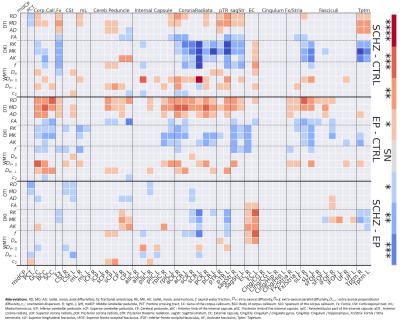 |
164 |
White and Grey Matter Microstructure Alterations in Early
Psychosis and Schizophrenia
Tommaso Pavan1,2,
Yasser Alemán-Gómez1,2,
Raoul Jenni2,3,
Martine Cleusix2,3,
Luis Alameda2,4,
Kim Quang Do Cuenod2,3,
Philippe Conus2,4,
Paul Klauser2,5,
Patric Hagmann1,2,
and Ileana Jelescu1,2
1Department of Radiology, Lausanne University Hospital (CHUV), Lausanne, Switzerland, 2University of Lausanne (UNIL), Lausanne, Switzerland, 3Center for Psychiatric Neuroscience, Department of Psychiatry, Lausanne University Hospital (CHUV), Lausanne, Switzerland, 4General Psychiatry Service, Treatment and Early Intervention in Psychosis Program (TIPP-Lausanne), Lausanne University Hospital (CHUV), Lausanne, Switzerland, 5Center for Psychiatric Neuroscience and Service of Child and Adolescent Psychiatry, Department of Psychiatry, Lausanne University Hospital (CHUV), Lausanne, Switzerland Keywords: Psychiatric Disorders, Microstructure, Schizophrenia, Neuroinflammation, Neurodegeneration, Microstructure, Diffusion, White Matter, Grey Matter In schizophrenia, widespread brain abnormalities are commonly reported but not the microstructure alterations. Here, we investigate brain microstructure during early psychosis and schizophrenia using DKI (in GM & WM), a clinically feasible extension of DTI, and we apply the White Matter Tract Integrity – Watson (WMTI-W, WM only) model. In WM, extensive alterations, consistent with demyelination, were found in early psychosis, while transitioning to chronic schizophrenia, microstructure changes become region-specific as indicated by the two ROI-dependent trends of disease progression found in this cohort. GM showed increased diffusivities and decreased kurtosis, but not widespread as in WM. |
|
4755.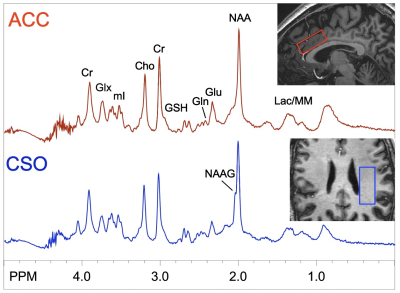 |
165 |
A pilot study of brain glutamine levels in schizophrenia and
control subjects: relationship to blood ammonia and cognition
Peter B Barker1,
Cykyra B Thomas1,
Dillip K Senapati1,
İpek B Özdemir1,
Semra Etyemez2,
Mark B Yoon1,
Vidya B Kamath1,
and Jennifer M Coughlin1
1JHU SOM, Baltimore, MD, United States, 2Obstetrics & Gynecology, Weill Cornell Medicine, New York, NY, United States Keywords: Psychiatric Disorders, Psychiatric Disorders, 7T, MRS, Schizophrenia, Metabolism, Glutamine It has previously been shown that brain glutamine (Gln) may be elevated is some patients with schizophrenia (Sz), and associated with cognitive deficits. Underlying causes of Gln elevation in Sz are unclear, but may be related to increased blood ammonia (NH3) levels. Brain Gln was measured in 12 subjects (5 Sz, 7 healthy controls (HC)) using 7T MR spectroscopy; brain Gln was found to correlate with blood NH3 levels (p < 0.05). and negatively correlate with measures of cognitive performance. This preliminary study therefore supports the hypothesis linking blood ammonia, brain Gln and cognitive performance. |
|
4756.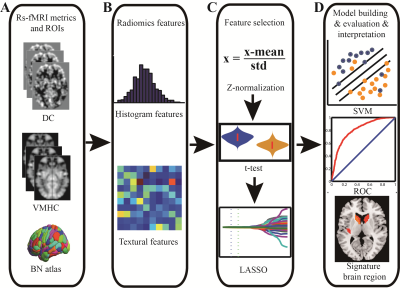 |
166 |
Neuroimaging biomarkers for detecting schizophrenia: a
resting-state functional MRI-based radiomics analysis
Dafa Shi1,
Haoran Zhang1,
Guangsong Wang1,
Xiang Yao1,
Yanfei Li1,
Siyuan Wang1,
and Ke Ren1
1Department of Radiology, Xiang’an Hospital of Xiamen Uneversity,School of Medicine, Xiamen University, Xiamen, China Keywords: Psychiatric Disorders, fMRI (resting state) Quantifiable biomarkers are urgently required to explore the potential physiological mechanism of schizophrenia and improve its diagnostic accuracy. Resting-state functional MRI (rs-fMRI)-based radiomics analysis obtained great classification performance, and it could be generalized to different brain atlases. The regions that we identified as discriminative features mainly included bilateral dorsal caudate and front-parietal, somato-motor, limbic, and default mode networks. Our findings showed that radiomics-based machine learning method could facilitate us to understand the potential pathological mechanism of schizophrenia more comprehensively and contribute to the accurate diagnosis of patients with schizophrenia. |
|
| 4757. | WITHDRAWN | ||
4758. |
167 |
Quantitative Susceptibility Mapping and Polygenic Risk Scores in
subjects with unusual and psychotic experiences obtained from
the UK Biobank
Marisleydis Garcia-Saborit1,2,3,
Carlos Milovic3,4,
Camilo Villaman5,
Eduardo Perez-Palma6,
Gabriela Repetto6,
Nicolas Crossley3,7,
and Cristian Tejos1,2,3
1Department of Electrical Engineering, Pontificia Universidad Catolica de Chile, Santiago, Chile, 2Biomedical Imaging Center, Pontificia Universidad Catolica de Chile, Santiago, Chile, 3Millennium Institute for Intelligent Healthcare Engineering, Santiago, Chile, 4School of Electrical Engineering, Pontificia Universidad Catolica de Valparaiso, Valparaiso, Chile, 5Center for Genomics and Bioinformatics, School of Sciences, Universidad Mayor, Santiago, Chile, 6Center for Genetics and Genomics, School of Medicine, Clinica Alemana Universidad del Desarrollo, Santiago, Chile, 7Department of Psychiatry, School of Medicine, Pontificia Universidad Catolica de Chile, Santiago, Chile Keywords: Psychiatric Disorders, Brain, dopamine, neuromelanin, genetics We evaluated a cohort of subject with unusual and psychotic experiences and control subjects obtained from the UK Biobank, and we studied the relationship between susceptibility (QSM) in deep brain nuclei and polygenic risk scores (PRS) of genetic variants associated to psychosis. Although we found significant differences between patients and controls for QSM and PRS, we did not find any relationship between these two variables. |
|
4759.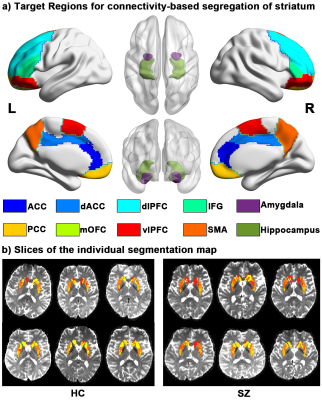 |
168 |
Disrupted striatum-centered tracts and positive symptoms in
schizophrenia patients
Yuanqiang Zhu1,
Chen Wang1,
Fan Guo1,
and Yingjuan Chang1
1Air Force Medical University, Xi'an, China Keywords: Psychiatric Disorders, Neuroscience Stronger tract strengths of the bilateral striatum with dlPFC were detected in schizophrenia patients. Our result provided system-level insights into abnormal connectivity strength of striatal circuits in schizophrenia patients. And the strength might have potential as neuroimaging biomarkers for positive symptoms. |
|
4760.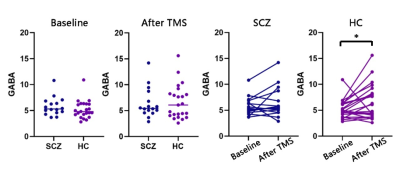 |
169 |
Altered cerebellar GABA-mediated cerebral functional networks in
patients with schizophrenia: A transcranial magnetic stimulation
study
Chenyang Yao1,2,
Youjin Zhao1,2,
Kai Ai3,
Bo Zhang4,
and Lui Su1,2,5
1Huaxi MR Research Center (HMRRC), Department of Radiology, West China Hospital of Sichuan University, Chengdu, China, 2Research Unit of Psychoradiology, Chinese Academy of Medical Sciences, Chengdu, China, 3Philips Healthcare, Xi'an, China, 4Mental Health Center, West China Hospital of Sichuan University, Chengdu, China, 5Functional and Molecular Imaging Key Laboratory of Sichuan Province, Chengdu, China Keywords: Psychiatric Disorders, Neuroscience, schizophrenia, cerebellum, gamma-aminobutyric acid (GABA) To investigate the cerebellar GABA-mediated cerebral functional networks, we measured cerebellar basal and stimulus-activated GABA content in schizophrenia patients (SCZ) and healthy controls (HC) with cerebellar transcranial magnetic stimulation (TMS). We utilized graph theory to calculate global and regional property changes of cerebral functional networks and their correlations with cerebellar GABA at baseline and after TMS. The results show significant increase of the global efficiency, nodal clustering coefficient of left ventral attention network (VAN) after TMS in SCZ. This provides new molecular evidence for neuropathology of cerebellum dysfunction in SCZ and reveal potential interaction with cerebral functional networks. |
|
4761.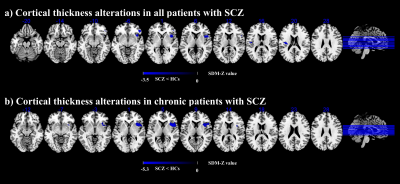 |
170 |
Alternations of Brain Local Cortical Thickness in Adult
Schizophrenia: A Surface-Based Morphometry Meta-Analysis
Shilin Sun1,
Shu Xiao1,
Jiaying Gong2,
Guixian Tang1,
Long Qian3,
and Ying Wang1
1Medical Imaging Center, First Affiliated Hospital of Jinan University, Guangzhou, China, 2Department of Radiology, Six Afliated Hospital of Sun Yat-sen University, Guangzhou, China, 3MR Research, GE Healthcare, Beijing, China Keywords: Psychiatric Disorders, Brain, Schizophrenia; Cortical thickness; Surface-based morphometry; Meta-Analysis Numerous neuroimaging studies have revealed abnormalities in specific brain regions in schizophrenia (SCZ), but results have been inconsistent. We conducted a whole-brain meta-analysis on surface-based morphometry studies between patients with SCZ and healthy controls by using the Seed-based d Mapping with Permutation of Subject Images (SDM-PSI) software. The meta-analysis demonstrated that SCZ exhibits abnormalities in cortical thickness in the inferior frontal gyrus, insula, and superior temporal gyrus. The results expand the current understanding of cortical thickness abnormalities in patients with SCZ, which would provide promising targets for therapeutic intervention. |
|
4762.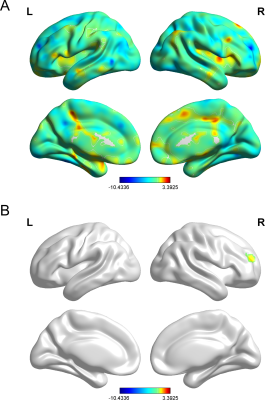 |
171 |
An analysis of longitudinal changes in dynamic brain activity
with MHE patients treated initially with artificial livers: A
follow-up fMRI study
Jiarui Zheng1,
Xueying Huang2,
Yuhui Xiong3,
Wenfu Ma1,
and Xiaodong Wang2
1Ningxia Medical University, Ningxia, China, 2General Hospital of Ningxia Medical University, Ningxia, China, 3GE Healthcare MR Research, Beijing, China, Beijing, China Keywords: Psychiatric Disorders, Brain, Minimal hepatic encephalopathy cognition Artificial liver support is an increasingly important intermediate step in the treatment of patients with liver failure. Yet there is still a lack of imaging studies to evaluate the efficacy of artificial liver support (especially on cognitive function of MHE). This study sought to evaluate the temporal variability of ReHo in the brain spontaneous activity after artificial liver support and correlated it with the PHES.We found that the dReHo in the right superior frontal gyrus decreased and were negatively correlated with NCT-A and positively correlated with DST.Dynamic regional indexes might be a novel neuro-imaging biomarker for artificial liver efficacy evaluation. |
|
4763.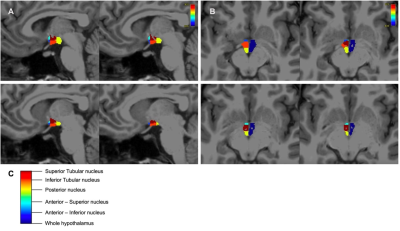 |
172 |
HYPOTHALAMIC VOLUME IS ASSOCIATED WITH BODY MASS INDEX
Stephanie S. G. Brown1,
Margaret Westwater2,
Jakob Seidlitz3,
Hisham Ziauddeen1,
and Paul Fletcher1
1Department of Psychiatry, University of Cambridge, Cambridge, United Kingdom, 2University of Oxford, Oxford, United Kingdom, 3University Pennsylvania, Philadelphia, PA, United States Keywords: Psychiatric Disorders, Segmentation, OBESITY The hypothalamus plays a major role in appetite regulation via well-defined orexigenic and anorexigenic pathways. Perturbation of these pathways is known to alter feeding behaviour and body mass. Using an automated technique, we segmented the hypothalamus in 1299 young adults with variation in body mass index (BMI). We showed that in participants who were overweight or obese, the hypothalamus and constituent nuclei were significantly increased in volume compared to those of a healthy weight. Further, these volume increases are predominantly localised to the arcuate and paraventricular nuclei, which form the core of the neuroendocrine appetite maintenance system. |
|
4764.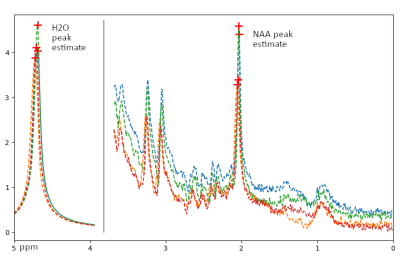 |
173 |
The selfish brain – Unaltered brain temperature in the acute
state of Anorexia Nervosa
Arne Doose1,
Alexander P. Lin2,
Tyler Chazan Starr2,
Katherine M. Breedlove2,
Jennifer Linn3,
and Stefan Ehrlich1,4
1Translational Developmental Neuroscience Section, Division of Psychological and Social Medicine and Developmental Neuroscience, Faculty of Medicine, Technische Universität Dresden, Dresden, Germany, Dresden, Germany, 2Center for Clinical Spectroscopy, Department of Radiology, Brigham and Women’s Hospital, Harvard Medical School, Boston, MA USA 02115, Boston, MA, United States, 3Institute of Diagnostic and Interventional Neuroradiology, University Hospital Carl Gustav Carus, Technical University, Dresden, Dresden, Germany, Dresden, Germany, 4Eating Disorder Research and Treatment Center, Department of Child and Adolescent Psychiatry, Faculty of Medicine, Technische Universität Dresden, Dresden, Germany, Dresden, Germany Keywords: Psychiatric Disorders, Spectroscopy, Brain temperature In anorexia nervosa (AN) restrictive food intake leads to a slowed metabolism. Brain temperature, can provide information about brain metabolism. Difference between Magnetic Resonance Spectrum peaks (ΔH20-NAA) provide a proxy for brain temperature in 30 AN and 30 healthy control (HC) participants. We found no group differences in brain temperature between AN/HC. Further, we report no group differences in brain temperature between a subgroup of the AN participants with the lowest BMI/body temperature compared to a subsample with higher BMI/body temperature. The results suggest a prioritization of brain metabolism in AN in line with the selfish brain hypothesis. |
|
4765.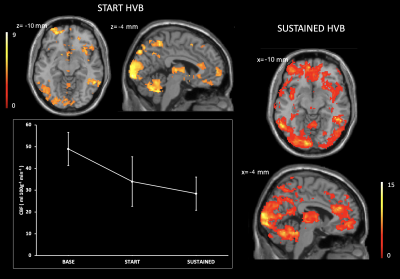 |
174 |
Cerebral haemodynamic correlates of altered consciousness states
induced by High-ventilation breathwork
Balázs Örzsik1,2,
Amy Kartar2,
Toru Horinouchi2,
Samira Bouyagoub2,
Brittany Anderson3,
Duncan Bailey4,
Hugo Critchley2,
Yoko Nagai2,
Iris Asllani2,5,
and Alessandro Colasanti2
1Radiology, Leiden Univeristy Medical Center, Leiden, Netherlands, 2Brighton and Sussex Medical School, Brighton, United Kingdom, 3Department of Psychiatry, University of Wisconsin School of Medicine and Public Health, Madison, WI, United States, 4Brighton BodyTalk, Brighton, United Kingdom, 5Rochester Institute of Technology, Rochester, NY, United States Keywords: Psychiatric Disorders, Perfusion ‘Breathwork’ is pursued by a rapidly growing set of adherents, anecdotally because it evokes psychedelic experiences that positively effect mood. We measured regional cerebral blood flow (rCBF) during high-ventilation breathwork (HVB) in healthy participants. Furthermore, we assessed the relationship between rCBF changes and subjective experience, focusing on altered state of consciousness. HVB was associated with substantial global reduction in CBF. Moreover, reduction in rCBF in anterior cingulate and insular cortices scaled with intensity of subjective experiences. These brain regions are implicated in supporting interoceptive control underlying affective regulation. Understanding the neural effects of HVB can inform new clinical applications. |
|
4766.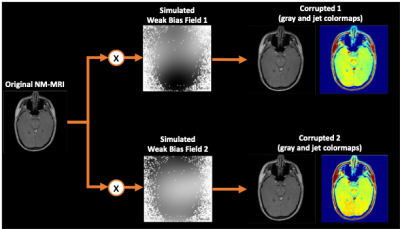 |
175 |
Investigation of nonuniform bias field in quantitative analysis
of neuromelanin-sensitive MR imaging
Junghwa Kang1,
Tea Young Lee2,
and Yoonho Nam1
1Department of Biomedical engineering, Hankuk University of Foreign Studies, Yongin, Korea, Republic of, 2Department of Neuropsychiatry, Pusan National University Yangsan Hospital, Yangsan, Korea, Republic of Keywords: Psychiatric Disorders, Psychiatric Disorders, neuromelanin, bias field correction Neuromelanin-sensitive MR imaging is an indirect method for assessing dopamine function. However, quantitative and objective analysis of NM-MRI is difficult because of field inhomogeneities or motion artifacts. To investigate the effect of nonunifrom bias field on quantitative analysis in NM-MRI, synthesized random bias fields were multiplied and compared the quantitative analysis using SN ROIs and reference ROIs. The results show a weak nonuniform bias field can reduce the reliability of quantitative analysis. |
|
4767.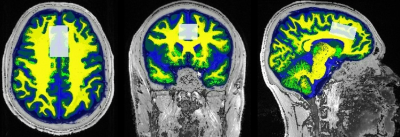 |
176 |
Assessing the Effect of Selective Serotonin Reuptake Inhibitor
on GABA and Neurometabolic Levels in the Brains of Violent
Offenders: A Pilot Study
Oun Al-iedani1,2,
James Brown-Miles2,
Jameen Arm2,
Tony Butler3,
Shiami Luchow2,
Claudia Hillenbrand4,
Peter W Schofield5,
and Saadallah Ramadan2,6
1School of Biomedical Sciences and Pharmacy, College of Health, Medicine and Wellbeing, University of Newcastle, Callaghan, Australia, 2Hunter Medical Research Institute, New Lambton Heights, Australia, 3School of Population Health, UNSW, Sydney, Australia, 4Research Imaging New South Wales, Division of Research & Enterprise, UNSW, Sydney, Australia, 5School of Medicine and Public Health, College of Health, Medicine and Wellbeing, University of Newcastle, Callaghan, Australia, 6School of Health Sciences, College of Health, Medicine and Wellbeing, University of Newcastle, Callaghan, Australia Keywords: Psychiatric Disorders, Brain Despite GABA implication in the regulation of aggression, the effects of selective serotonin reuptake inhibitor (SSRI) on GABA and Glx in an impulsive-aggressive population is yet to be explored. Seven repeat-offenders were treated with Sertraline and underwent MRI/MRS scans pre- and post-treatment (3-4 weeks of treatment). No significant changes (p≥0.05) in ACC-GABA+ or ACC-Glx were reported. Significant reduction in ACC-Glx/tCr (p=0.02) and increase in ACC-NAA (p=0.05) were found, while MM09+L09 increase approached significance (p=0.06). Further investigation is warranted. SSRIs clearly exert secondary effects on Glx levels in the ACC, with possible effects on NAA and MM09+L09. |
|
4768.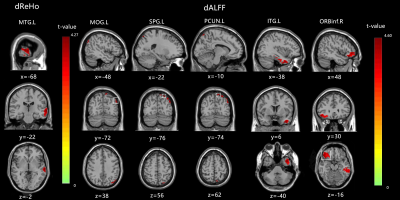 |
177 |
Regional dynamic brain function changes in adults with autism
spectrum disorder
Xipeng Yue1,
Yu Shen1,
Ying Li2,
Ge Zhang1,
Xiaochen Li1,
Wei Wei1,
Yan Bai1,
Jiapei Xie1,
Xinhui Wang1,
Zhi Luo1,
Xianchang Zhang3,
and Meiyun Wang*1,4
1Department of Medical Imaging, Henan Provincial People’s Hospital, ZhengZhou, China, 2Department of Rehabilitation Medicine, Henan Provincial People’s Hospital, ZhengZhou, China, 3MR Collaboration, Siemens Healthineers Ltd., Beijing, China, 4Laboratory of Brain Science and Brain-Like Intelligence Technology, Institute for Integrated Medical Science and Engineering, ZhengZhou, China Keywords: Psychiatric Disorders, fMRI (resting state) Most neuroimaging studies investigating autism spectrum disorder (ASD) have focused on static brain function and used children as research subjects. However, this study investigated dynamic changes of regional neural function in adult ASD patients. Significant differences in dynamic regional homogeneity (dReHo) and dynamic amplitude of low-frequency fluctuation (dALFF) were observed based on resting state fMRI in several brain areas, such as the left middle/inferior temporal gyrus and left middle occipital gyrus. A significant correlation was found between clinical scores and the dReHo/dALFF values. These results suggested that dynamic regional brain function might be helpful in understanding neural mechanisms in ASD . |
|
4769.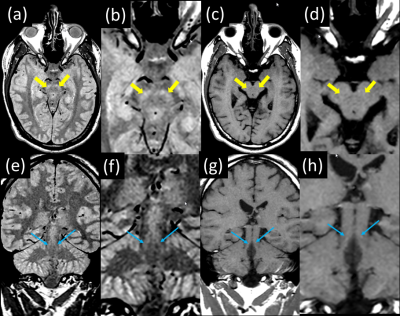 |
178 |
Neuromelanin Imaging at 0.5T Reveals Elongated T1 in
Neuromelanin-Rich Brain Regions In Vivo
Jeff Stainsby1,
Andrew Curtis1,
Sofia Chavez1,
and Chad Harris1
1MR, Synaptive Medical, Toronto, ON, Canada Keywords: Psychiatric Disorders, Contrast Mechanisms, Neuromelanin Mid-field imaging benefits from increased T1 tissue differentiation and reduced SAR constraints for generating MT contrast. These were leveraged in imaging of neuromelanin containing structures at 0.5T. Elevated T1 values in the substantia nigra and locus coeruleus were demonstrated. Contrary to T1-weighted approaches reported in the literature a proton density weighted fast spin echo approach is shown to provide improved visualization at mid-field and implies modified strategies at higher field would be beneficial. |
|
4770.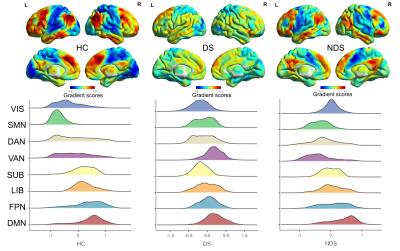 |
179 |
Brain functional network hierarchy and neurochemical correlates
in deficit and non-deficit schizophrenia
Chengmin Yang1,
Li Yao1,
Jiajun Liu2,
Zhipeng Yang2,
and Su Lui1
1Huaxi MR Research Center (HMRRC), Functional and molecular imaging Key Laboratory of Sichuan Province, Department of Radiology, West China Hospital, Sichuan University, Chengdu, China., Chengdu, China, 2College of Electronic Engineering, Chengdu University of Information Technology, Chengdu, P.R. China., Chengdu, China Keywords: Psychiatric Disorders, Gradients By combining the brain hierarchy changes and their likely potential molecular signatures, we found that the compression of the cortical hierarchy organization in deficit schizophrenia (NS) and non-deficit schizophrenia (NDS) with neurochemical correlates. The altered functional gradients were spatially positively correlated with the receptor of 5-HT2a in DS patients, while negatively correlated with receptor of D1/2 in NDS patients, which revealed the underlying physiological mechanisms of the heterogeneity in schizophrenia. |
|
The International Society for Magnetic Resonance in Medicine is accredited by the Accreditation Council for Continuing Medical Education to provide continuing medical education for physicians.